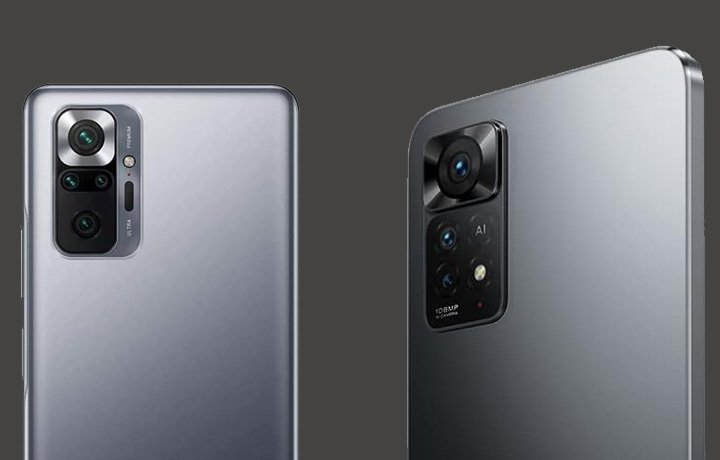Redmi Note 11 Pro vs. Redmi Note 10 Pro: A Comprehensive Comparison Review
Redmi has consistently delivered devices that cater to a wide range of users. In this comparison review, we’ll delve into the battle between the Redmi Note 11 Pro and the Redmi Note 10 Pro. Each device has its strengths and weaknesses, offering distinct experiences for users with varying preferences and needs.
- Check out these as well:
- Huawei Nova 11 Pro Review
- Samsung Galaxy A14 5G Review
- Xiaomi Mix Fold 2 Review:
Build Quality and Durability
When it comes to build quality, both the Redmi Note 11 Pro and Redmi Note 10 Pro showcase their unique strengths. The Redmi Note 11 Pro’s front is protected by Corning Gorilla Glass 5, offering some protection against scratches. However, the frame is made from plastic, and surprisingly, the rear lacks any protection, making it vulnerable to cracks and damage.
On the other hand, the Redmi Note 10 Pro features Corning Gorilla Glass 5 protection on both the front and rear, offering more comprehensive safeguarding against potential accidents. This gives the Redmi Note 10 Pro a clear advantage in terms of overall build quality and protection.
Design and Weight
Design aesthetics play a pivotal role in a user’s experience, and both devices showcase distinct design elements. The Redmi Note 11 Pro’s plastic frame and glass back contribute to its overall appearance, but the Redmi Note 10 Pro’s seamless combination of Corning Gorilla Glass 5 on both sides gives it a more polished and premium feel.
Additionally, the Redmi Note 10 Pro’s lighter weight and ergonomic curves make it more comfortable to hold, granting it an edge in terms of user comfort.
Display
Both smartphones boast 6.67-inch 1080p AMOLED displays, making them visually impressive for media consumption.
However, the Redmi Note 11 Pro gains an advantage with its higher touch sampling rate of 360Hz, which results in a smoother and more responsive touch experience compared to the Redmi Note 10 Pro’s 240Hz sampling rate. This difference becomes evident when scrolling, enhancing the overall user experience.
Performance
Under the hood, the Redmi Note 11 Pro and Redmi Note 10 Pro feature different processors, with the former housing a MediaTek Helio G96 and the latter sporting a Snapdragon 732G. Benchmark scores indicate that the Redmi Note 11 Pro outperforms the Redmi Note 10 Pro in certain scenarios, but these scores do not provide a comprehensive view of real-world performance.
In actual usage, the Redmi Note 10 Pro proves to be more efficient and cooler during intense tasks, like gaming. The Redmi Note 11 Pro may experience thermal throttling, which affects its performance during extended usage, making the Redmi Note 10 Pro a more reliable choice for demanding applications.
Gaming and Cooling
Gaming performance is crucial for many users, and here the Redmi Note 10 Pro shines. Equipped with the Adreno 618 GPU, it offers smoother gameplay experiences in titles like PUBG, Call of Duty Mobile, and Genshin Impact.
In contrast, the Redmi Note 11 Pro’s Mali G57 GPU struggles with consistent performance due to thermal issues. While it features a cooling system, it still becomes notably hot during prolonged gaming sessions, leading to throttling and impacting gameplay.
Camera
Camera quality is an essential consideration for smartphone users. Both devices offer a 16-megapixel selfie camera, but when it comes to the rear cameras, the Redmi Note 10 Pro emerges as the winner. In various lighting conditions, the Redmi Note 10 Pro produces more balanced and natural-looking images.
Despite the Redmi Note 11 Pro’s Magenta tint in certain shots, both devices produce impressive results. However, the versatility and additional camera features available on the Redmi Note 10 Pro, such as dual video mode and vlog mode, make it a more attractive option for photography enthusiasts.
Battery and Charging
Battery life and charging times are pivotal factors in a smartphone’s usability. While both devices offer similar screen-on times, the Redmi Note 11 Pro boasts faster charging speeds, thanks to its efficient charging technology. This gives users the advantage of quicker recharging, enhancing overall convenience.
Conclusion
In the Redmi Note 11 Pro vs. Redmi Note 10 Pro face-off, each device has its strengths and weaknesses. The Redmi Note 10 Pro emerges as the better device overall, offering superior build quality, ergonomic design, enhanced gaming performance, and a more versatile camera system.
Despite the Redmi Note 11 Pro’s advancements in display touch sampling and faster charging, its thermal issues and compromised gaming experience hold it back. If you’re in the market for a smartphone that combines a balanced blend of performance, camera capabilities, and user comfort, the Redmi Note 10 Pro stands as the clear winner.
- Shop On Amazon Using Our Links To Support Us:
- Amazon under $25:
- Amazon best sellers:
- Amazon most gifted:










